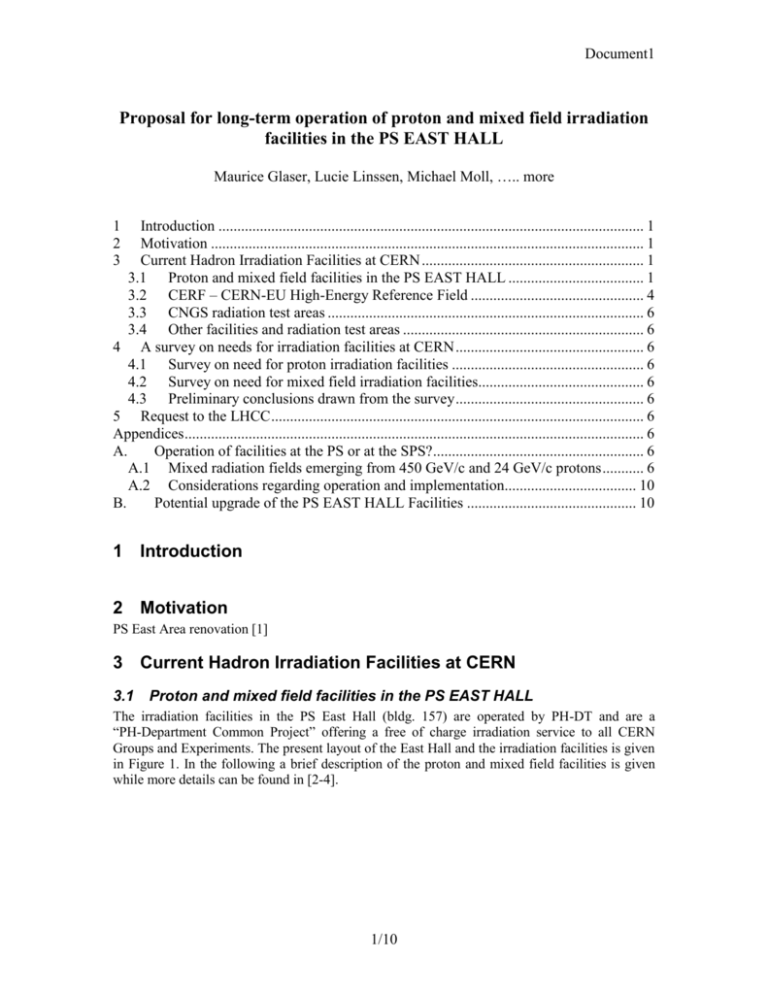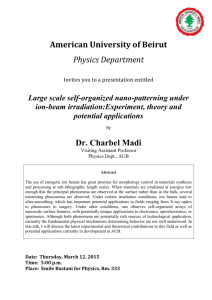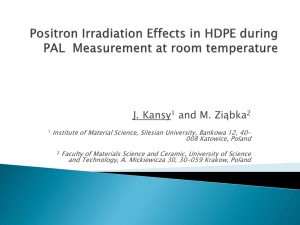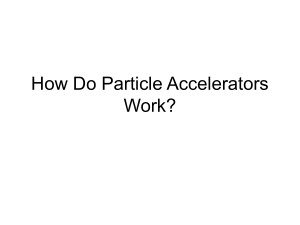100412a-LHCC-proposal - Indico
advertisement

Document1 Proposal for long-term operation of proton and mixed field irradiation facilities in the PS EAST HALL Maurice Glaser, Lucie Linssen, Michael Moll, ….. more 1 2 3 Introduction ................................................................................................................. 1 Motivation ................................................................................................................... 1 Current Hadron Irradiation Facilities at CERN ........................................................... 1 3.1 Proton and mixed field facilities in the PS EAST HALL .................................... 1 3.2 CERF – CERN-EU High-Energy Reference Field .............................................. 4 3.3 CNGS radiation test areas .................................................................................... 6 3.4 Other facilities and radiation test areas ................................................................ 6 4 A survey on needs for irradiation facilities at CERN .................................................. 6 4.1 Survey on need for proton irradiation facilities ................................................... 6 4.2 Survey on need for mixed field irradiation facilities............................................ 6 4.3 Preliminary conclusions drawn from the survey .................................................. 6 5 Request to the LHCC ................................................................................................... 6 Appendices .......................................................................................................................... 6 A. Operation of facilities at the PS or at the SPS? ........................................................ 6 A.1 Mixed radiation fields emerging from 450 GeV/c and 24 GeV/c protons ........... 6 A.2 Considerations regarding operation and implementation................................... 10 B. Potential upgrade of the PS EAST HALL Facilities ............................................. 10 1 Introduction 2 Motivation PS East Area renovation [1] 3 Current Hadron Irradiation Facilities at CERN 3.1 Proton and mixed field facilities in the PS EAST HALL The irradiation facilities in the PS East Hall (bldg. 157) are operated by PH-DT and are a “PH-Department Common Project” offering a free of charge irradiation service to all CERN Groups and Experiments. The present layout of the East Hall and the irradiation facilities is given in Figure 1. In the following a brief description of the proton and mixed field facilities is given while more details can be found in [2-4]. 1/10 Document1 Mixed Field Facility Proton Facilities Figure 1: Layout of irradiation facilities in the PS EAST Hall (bldg. 157). Proton and mixed field irradiation areas are indicated in blue. Protons from the PS are entering the Hall from the left hand side. (Is there a newer version of the EAST HALL layout?) 3.1.1 PS EAST HALL: Proton irradiation facilities The proton irradiation facilities are located in the T7 beam line of the PS East Hall (see Figure 1). The primary 24 GeV/c proton beam is spread and swept within an extraction time of 450 ms over a ~2x2cm2 beam spot. A computer controlled shuttle system (IRRAD 1) allows for placing samples into the beam line without access of personal to the primary area. Furthermore, two independent x-y-z tables carrying temperature and ambient controlled boxes (IRRAD 3 and IRRAD 5) that can be scanned over the beam are located in the T7 primary beam line area. These boxes can house bigger objects, have however the disadvantage that an access to the primary area is needed (implying a beam stop for the whole East Hall and exposure of personal to radiation). In all facilities samples can be electrically connected during irradiation. IRRAD 1 (Shuttle): Beam spot: 2x2 cm2; Flux: 1-101013 p/cm2/h IRRAD 3 (Box): Size of box: 50 x20x20 cm3; Scanned area: 400 cm2; Flux: 1-10 1011 p/cm2/h IRRAD 5 (Box): Size of box: 2 times 15 x 15 x30 cm3; Scanned area:49 cm2; Flux: 8-801011 p/cm2/h IRRAD 6: Characterized radiation field of backscattered particles used e.g. for Radiation monitor or SEU testing (~100-500 mGy/h) 3.1.2 PS EAST HALL: Mixed field irradiation facility The mixed field irradiation facility is located behind the DIRAC experiment in the T8 beam line of the PS East Hall. The primary beam is directed on a carbon (50cm) – iron (30cm) block. A cavity located behind this block is accessible via a computer controlled shuttle system and used for the irradiation experiments. The radiation field is a composure of different kind of particles (mainly fast neutrons) and strongly depending on the distance from the beam axis. Samples can be electrically connected during irradiation. IRRAD2 (Shuttle): Max sample size: 30x30x35 cm3, 5Kg; Flux: 3-101011 n/cm2/h (1 MeV neutron equivalent flux). 2/10 Document1 3.1.3 PS EAST HALL: Services provided by the operating team (PH-DT) Besides the operation and maintenance of the facilities the following services are offered to clients: Consulting and planning of the experiment: The facility staff has 18 years of experience in planning and performing irradiation experiments in the PS East Hall. Furthermore, it is strongly involved in R&D programs aiming on the improvement of the radiation tolerance of semiconductor detectors (CERN-RD48, RD50). Often custom mechanical supports for special radiation experiments are designed and/or produced for clients. Irradiation: For simple irradiation experiments the presence of the user is not required during irradiation. Irradiations are entirely performed by the facility team. The whole irradiation procedure: User registration, irradiation request, acceptance of experiment, irradiation experiment, online and offline dosimetry results and shipping are completely transparent for the user via www-interfaces and online databases. Dosimetry: A wide range of dosimetry measurements starting from online SEC counter monitoring to complex offline beam profiling measurements with Optically Stimulated Luminescence (OSL) films are offered. Silicon pin-diodes, RADFETs, Alanine dosimeters, OSL films, Dye films and various activation foils are used. The latter are measured in NaI or Ge spectrometers operated and maintained by the facility team. The dosimetry is under constant development as expressed in the R&D and service activity in the framework of the CERN-RADMON project. The radiation field in the neutron facility as well as the secondary particle radiation field in the proton facility (used for SEU tests) have been calculated by Monte Carlo simulations and are available for the users. Storage: Several shielded storage facilities for radioactive materials are provided which are approved and constantly controlled by the radioprotection group. Irradiated devices can be stored under various conditions (e.g. cold and under nitrogen atmosphere). Shipping: The facility team is only interfacing between clients and the CERN radioactive material shipping service, but is also providing several safety approved shipping containers that allow e.g. for cold and temperature monitored transport of irradiated material. The good relation with the shipping service is e.g. expressed by the fact that the database and webinterface that tracks the status and validity of radioactive material handling licenses of outside CERN institutes has been written by the facility team. Irradiations outside of CERN: Due to the involvement of the irradiation team in various R&D projects, a close network with other complementary irradiation facilities outside CERN has been established. Upon request irradiation campaigns outside of CERN are organized (e.g. pion irradiations at the PSI Villingen or neutron irradiations at the nuclear reactor at the Jozef Stefan Institute, Ljubljana or the fast neutron source at Louvain-La-Neuve). Infrastructure for electrical device characterization: The complexity of the irradiation experiments has risen over the past years and often online measurements or measurements directly after irradiation are required. Computer controlled set-ups to measure CV/IV curves and various setups for resistive online measurements are provided. Safety: All aspects regarding general and radiation safety are closely followed up and constantly improved in close collaboration with the relevant CERN safety authorities. All 3/10 Document1 irradiated materials are traced in conjunction with the radiation protection group in an onlinedatabase. For handling and manipulating activated material dedicated workplaces are available for facility clients. 3.1.4 PS EAST HALL: Irradiation experiments performed over the last years The first irradiations were performed in 1992 in the T7 line in the framework of silicon detector developments. A strongly increasing demand for irradiation experiments around 1996 led to the development of the shuttle systems that were installed in 1998 (protons) and 1999 (neutrons). Since then the number of demands and the complexity of the experiments were further rising resulting in the installation of further counting rooms and the scanning boxes in the T7 primary area. Since 2001 the facilities are a Common Project of the PH-Department. Figure 2 gives an overview about the irradiations performed in the proton irradiation facility over the years 19992007. Main users have been and are the tracking detector communities of the LHC experiments. Figure 2: Number of irradiated samples and number of performed dosimeter measurements. In 2005 no beams were available at CERN and in 2006 the breakdown of PS magnet systems strongly reduced the available beam time. (Need to include 2008/2009 data!) 1600 1400 Samples irradiated 1200 Dosimeters measured Number 1000 800 600 400 200 0 1999 2000 2001 2002 2003 2004 2005 2006 2007 Year 3.2 CERF – CERN-EU High-Energy Reference Field 3.2.1 CERF – Facility layout and spectra The CERF facility [5] (Figure 3) is installed in one of the secondary beam lines (H6) from the Super Proton Synchrotron (SPS) in the North Experimental Area. Figure 3: Layout of the CERF facility in the North Experimental Hall of the SPS as modeled in FLUKA. The side shielding is removed to show the inside of the irradiation cave with the copper target setup A positive hadron beam with momentum of usually 120 GeV/c is impinging on a copper target, 7 cm in diameter and 50 cm in length, which can be installed in two different positions inside an irradiation cave. In the past also other beam energies between 20 GeV and 205 GeV were used. The secondary particles produced in the target traverse a shielding of either 80 cm concrete or 4/10 Document1 40 cm iron. On top of these roof-shields well defined radiation fields are produced over two areas of 2x2 m2, each of them divided into 16 squares of 50x50 cm2. Each element of these “grids” represents a reference exposure location. The energy distributions of the particles at the various exposure locations have been obtained by Monte Carlo simulations performed with the FLUKA code [6,7]. The neutron energy distribution on top of the concrete shield shows a marked highenergy neutron component, at an energy of 10 – 100 MeV, resembling fairly closely the neutron field produced by cosmic rays at commercial flight altitudes, while the spectrum outside the iron shield is rather dominated by neutrons in the 0.1 – 1 MeV range. For the Concrete and the Iron Top positions, additional muon and neutron components are present which directly come from the TCC2 primary target area located upstream of CERF, from the H6 beam line and from the adjacent H8 line. Their intensity depends on various factors which are not under direct control, such as the intensity of secondary beams in neighbouring beam lines. The intensity of the primary beam hitting the target is monitored by an air-filled Precision Ionisation Chamber (PIC) at atmospheric pressure, placed in the beam upstream of the copper target. By adjusting the beam intensity on the target one can vary the dose equivalent rate at the reference positions, typically up to 1 mSv/h on the iron roof-shield and up to 500 µSv/h on the 80 cm concrete roof or lateral shield. In addition to the top shielding positions, measurement positions are also available behind the lateral side shielding of the irradiation cave and inside the cave around the target position. Figure 4 and Figure 5 show the particle fluence distributions for two typical irradiation locations lateral and downstream of the target. 0.1 0.1 neutrons photons ch. hadrons + e /e Position 4 0.01 1E-3 1E-3 1E-4 d/dln(E) d/dln(E) 1E-4 1E-5 1E-6 1E-5 1E-6 1E-7 1E-7 1E-8 1E-8 1E-9 1E-4 neutrons photons ch. hadrons + e /e Position 6 0.01 1E-3 0.01 0.1 1 10 1E-9 1E-4 100 1E-3 0.01 0.1 1 10 100 Energy (GeV) Energy (GeV) Figure 4: Typical particle fluence spectra obtained in reference position 4 lateral to the target. Figure 5: Typical particle fluence spectra obtained in reference position 6 downstream of the target. 3.2.2 CERF - Overview of experimental applications and recent experiments Several measurement campaigns have taken place at CERF starting in 1992. Many institutions from all over Europe, as well as from the USA, Canada and Japan, have used the facility to test various types of passive and active detectors. These included devices such as high pressure ionization chambers, TEPCs, GM-counters, different types of rem counters, bubble detectors, scintillation based dose-rate meters, electronic pocket dosemeters, Si-diodes, solid state nuclear track dosemeters (SSNTD), thermoluminescent dosemeters (TLD), films, recombination chambers, multisphere systems. Although most of the beam time was dedicated to test dosimetric instrumentation, the facility has also been exploited for other uses. Experimental applications for which the facility has been used include test and intercomparison of active instrumentation and passive devices, test of active and passive dosemeters used for individual monitoring, calibration of devices before their use for in-flight measurements either on commercial flights or in space, various tests related to the LHC project, investigations of computer memory upsets and 5/10 Document1 radiobiological studies. Several benchmark experiments for Monte Carlo based particle transport codes like FLUKA were also performed. Since 2003 the irradiation positions close to the target have also been used. Typical applications at this location are material activation studies and highlevel dosimetry calibrations, studies of detector responses of beam loss monitors and ionization chambers to mixed high-energy radiation fields. Need some more data on users! 3.3 CNGS radiation test areas 3.4 Other facilities and radiation test areas Mention GIF++ and HIRADMAT for completeness 4 A survey on needs for irradiation facilities at CERN The CERN Working Group for Future Irradiation Facilities [8] has recently carried out a survey on the demand and requirements for future irradiation facilities at CERN. Gamma, Proton, Ion and Mixed Field irradiation facilities were considered. The survey was sent to a large community of potential users. A web-based questionnaire was prepared for each type of facility addressing questions regarding the required radiation field, the facility infrastructure, the irradiation experiments to be performed, the annual required beam time and the time scale for the projects that would be performed in the facilities. In the following two sections the feedback obtained for the proton and mixed field irradiation facilities is summarized. The third and last section of this chapter gives the (preliminary) overall outcome of the survey for all type of facilities. 4.1 Survey on need for proton irradiation facilities 4.2 Survey on need for mixed field irradiation facilities 4.3 Preliminary conclusions drawn from the survey 5 Request to the LHCC Appendices A. Operation of facilities at the PS or at the SPS? A.1 Mixed radiation fields emerging from 450 GeV/c and 24 GeV/c protons Based on a work by E.Feldbaumer and H.Vincke (CERN-DGS/RP)[9]. This chapter presents the comparison between the radiation fields emerging from a proton beam impact on a copper target at a momentum of 24 GeV/c and 450 GeV/c. The target is cylindrically shaped with a length of 50 cm and a diameter of 7 cm. In the FLUKA simulations it is placed in the target position of the so called CERF++ area, which is a conceptual design study of an irradiation facility (see Figure 6 left side). The area close to the target is foreseen to be used as high dose irradiation area, which is exposed to the high-energy particles emerging directly from 6/10 Document1 the target. The inner part of CERF++ is surrounded by a shielding construction made of concrete and iron. Behind the shielding a second irradiation area is located. The radiation fields in this area are defined by the shielding material between the measurement location (iron or concrete) and by the angle between the beam direction and the axis which is defined by the target position and the measurement location outside the shielding. In general, the radiation fields located downstream the target show a strong component of high-energy particles, whereas locations located lateral and upstream the target are rather dominated by the low-energy component emerging from the particle cascade. In order to compare the two scenarios 12 locations have been chosen to elaborate the differences in the various radiation fields. These locations are presented in Figure 6 (right side). 10 9 11 5 4 8 1 2 3 6 7 Figure 6: Conceptual design of the CERF++ irradiation facility (left site) and hypothetical measurement positions chosen for the radiation field comparison between 24 and 450 GeV/c proton irradiations. The right picture shows the locations (green circles) used for the comparison of the radiation fields. The comparison of the two scenarios is based on a beam intensity of 1011 protons for the 24 GeV/c and 1010 protons at 450 GeV/c which is sent onto the target within a cycle period of 16.8 seconds (called spill). Considering these intensities equivalent radiation conditions in terms of dose rates are created at most measurement locations. Results Figure 7 presents the comparison of the dose rates that were calculated for the 450 GeV/c and the 24 GeV/c beam impacts. The result of the 450 GeV/c scenario was scaled with a beam intensity of 1010p/16.8s, whereas the dose rate color plot of 24 GeV/c beam impact was scaled with a 10 times higher intensity. 7/10 Document1 Figure 7: Cross section through the CERF++ area showing the dose rate at beam height. The purple contour line in the 450 GeV/c picture indicates the areas of a dose rate of 15 uSv/h. The blue line in the right picture serves the same purpose for the 24 GeV/c picture. To compare the two scenarios, the purple line is also displayed in the right plot. The comparison of the two color plots shows clearly that the dose rate conditions are very similar for both cases lateral and upstream the target position. In forward direction behind the iron dump a much higher dose rate can be found for the 450 GeV/c primary beam. The dominance of the 450 GeV/c scenario can be explained by the production of high-energy muons capable to penetrate thick shielding walls without being absorbed. In the right picture of Figure 7 contour lines (purple and blue) indicate the locations with dose rates of 15 uSv/h for the two different scenarios. Also here a resemblance of the two radiation fields in the lateral and upstream direction and the distinction in the forward direction can be found. Figure 8 presents the comparison of the fluence spectra at the measurement positions 1, 2, 8 and 10 (see Figure 6, right picture). Inside downstream (Position 1) Inside downstream (Position 1) Inside lateral (Position 2) Inside lateral (Position 2) 8/10 Document1 Outside downstream (Position 10) Outside lateral (Position 8) Figure 8: Comparison of the radiation fields seen at the measurement positions 1, 2, 8 and 10 emerging from the two different scenarios. The fluence scale, normalized to particles per primary proton, is displayed on the left side of the pictures for the 450 GeV/c case and on the right side for the 24 GeV/c scenario. A more detailed comparison of the various fluence spectra shows the following results: Inside downstream (position 1): The hadronic and muon fluences originating from the 24 GeV/c beam differ from their 450 GeV/c counterparts above an energy of several 100 MeV. Also the electromagnetic particle cascades observed at these locations show a clear dominance of the high-energy particles in case of the 450 GeV/c scenario. As expected the maximum energy of the fluences at this location can be found at the respective primary beam energy. Hence, the spectrum emerging from the 450 GeV/c beam impact ranges up to this momentum, whereas the spectra of its counterpart scenario end at 24 GeV/c. Inside lateral (position 2): Both the electromagnetic and the hadronic cascades emerging from the 24 GeV/c and the 450 GeV/c scenario show strong resemblances. Outside downstream (position 10): At the outside downstream position a strong muon components arises in the case of the 450 GeV/c scenario. The spectra of other particles than muons show strong similarities in case of the two different primary beam energies. This strong dominance of muons emerging from the 450 GeV/c beam impact result in a creation of a well defined muon field at this location. However, this strong muon component is also leading to radiation protection problems since muons at high energies are not subject to the strong interaction force. Hence, for a significant attenuation of the muon beam very thick shieldings are 9/10 Document1 required. E.g.: to eliminate a muon with an energy of 100 GeV an iron shielding of a thickness of 70 m would be needed. Outside lateral (position 8): Both the electromagnetic and the hadronic cascades emerging from the 24 GeV/c and the 450 GeV/c scenario show strong resemblances. The particle fluence spectra at all other measurement locations (3 -7, 9 and 11) show very similar shapes for the two different energies. Conclusion A beam-on-target radiation facility using a 24 GeV/c proton beam will produce particle fluence spectra which are similar at most locations to the ones emerging from a 450 GeV/c proton facility. Only the positions located downstream the target show significant differences in the high-energy ranges of the fluence spectra. Behind the 4 m thick iron shielding, which is located downstream the CERF++ target, a strong muon component can be found in the 450 GeV/c scenario. This “muon calibration field” cannot be produced by the 24 GeV/c irradiation setup. This well defined high-energy muon field can be seen as an advantage of the 450 GeV/c beam facility. However, one has also to consider the radiation protection difficulties to shield high-energy muon radiation. A.2 Considerations regarding operation and implementation B. Potential upgrade of the PS EAST HALL Facilities Acknowledgements References [1] Lau Gatignon, “East Area Renovation”, IEFC Workshop 2010, http://indico.cern.ch/conferenceDisplay.py?confId=70866 [2] PS East Hall Irradiation facilities web page: http://irradiation.web.cern.ch/irradiation/ [3] M.Glaser et al., NIM A 426(1999). [4] M.Glaser et al., IEEE TNS, Volume 53, Issue 4, 2006, 2016 – 2022. [5] A. Mitaroff and M. Silari. The CERN-EU high-energy Reference Field (CERF) facility for dosimetry at commercial flight altitudes and in space. Radiation Protection Dosimetry 102, 7-22, 2002 [6] A. Fasso`, A. Ferrari, J. Ranft, and P.R. Sala, FLUKA: a Multi-Particle Transport Code, CERN-200510 (2005), INFN/TC_05/11, SLAC-R-773. [7] A. Fasso` et al., The Physics Models of FLUKA: Status and Recent Developments, Computing in High Energy and Nuclear Physics 2003 Conference (CHEP2003), La Jolla, CA, USA, March 24-28, 2003, (paper MOMT005), eConf C0303241 (2003), arXiv:hep-ph/0306267. [8] Working group on Future Irradiation Facilities at CERN: http://www.cern.ch/irradiation-facilities [9] E.Feldbaumer and H.Vincke, “Radiation field emerging from the impact of a 450 GeV/c and a 24 GeV/c proton beam”, presented on 13.6.2008 on the “Irradiation Facilities Working Group” Meeting. 10/10






